I knew finding vegetarian food in Istanbul wouldn’t be difficult. Turkish cuisine has plenty of authentic dishes that don’t rely on meat — lentil soup, meze plates, gözleme (gurhz-leh-meh) — and I always do a little background before I travel to see what the most popular foods are. The cuisine itself makes it easier: it’s built around fresh vegetables, grains, yogurt, herbs, and spices, with bread at nearly every meal.
Still, the fun of traveling isn’t just sticking to what’s safe. For me, it’s about sharing in the local cuisine and noticing how food and drink reflect the culture. That’s one reason I was especially looking forward to the coffee. A friend from the Middle East often made Turkish coffee for me at home, and I loved watching the slow brewing process in the little pot.
The taste always surprised me — strong, yes, but layered, and his version had a slight cinnamon note that made each cup feel warm and complex. Sitting down to drink it in Istanbul, with the clink of tiny cups and the city moving outside, felt like I was experiencing something familiar but in the place where it truly belongs.
During my five days, I found plenty of flavorful dishes. If you’re looking for vegetarian food in Istanbul, you’ll have no trouble — from breakfasts and street snacks to meze spreads, I sometimes repeated meals, but I never felt left out.
Breakfast at Hotel Daryssaade was so good that I never once felt the need to hunt down a café in the mornings. The coffee was strong and satisfying, and the buffet was overflowing with choices: fresh fruit, warm pastries, sesame-topped rolls, and little fried dough balls dusted with sugar. There were platters of local cheeses and olives, colorful salads with grains and lentils, yogurt dips, and cooked vegetables in olive oil. My favorite thing, though, was the spinach-and-cheese börek — flaky, golden, and perfectly savory. It became my go-to every morning before heading out for the day.
After those big breakfasts, I didn’t always need a full sit-down lunch, but if I was ever a bit hungry, street food was an easy answer. Little red carts were everywhere — in the squares, along the waterfront, and on the side streets. The most common thing they sold was simit (see-mit), sesame-covered bread rings that are crisp on the outside, chewy on the inside, and filling. They reminded me of a cross between a bagel and a pretzel, and locals often ate them plain or with a bit of cheese. Simit became my easiest snack on the go.
Other vendors sold roasted chestnuts or grilled corn on the cob, and you could usually smell them before you saw the cart. If fruit was what I was craving, there were plenty of stands selling fresh apples, grapes, and pomegranates — seasonal, colorful, and refreshing in the middle of the day.
In the bazaars, the options multiplied. Stalls were stacked with piles of pistachios, cashews, hazelnuts, and almonds, along with bags of mixed dried fruit. These weren’t just snacks to tide me over — they were part of the market’s energy itself, colorful displays that made even the simple act of grabbing a handful of nuts feel like a taste of Istanbul. Between the carts and the bazaars, I was never far from something quick, fresh, and vegetarian-friendly.
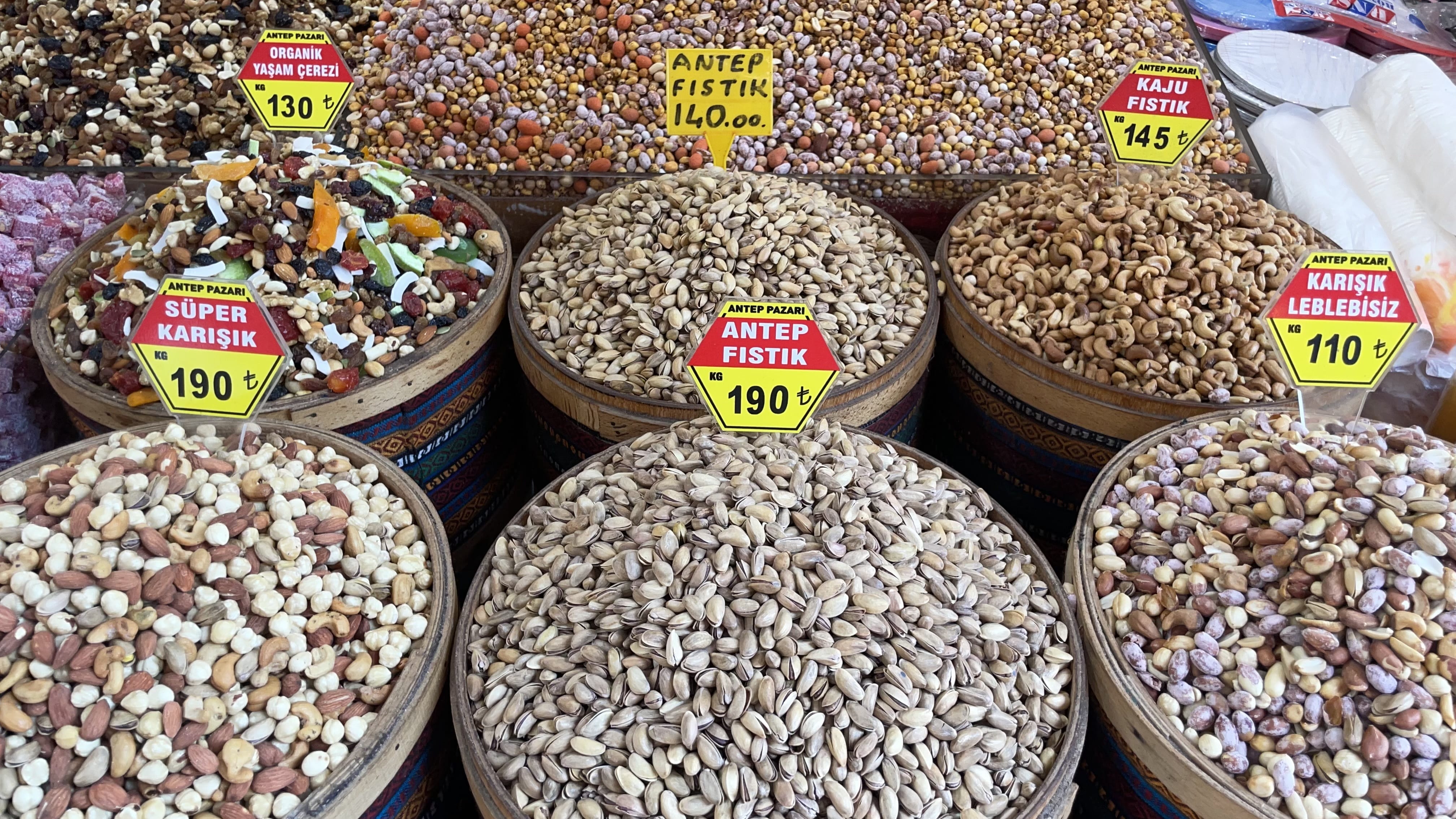
When I did sit down for a meal, lunch or dinner was never a problem as a vegetarian. Mercimek çorbası (mehr-ji-mek chor-ba-suh), the classic red lentil soup, was hearty and filling — I ordered it more than once. It usually had cumin and other spices that gave it depth without being heavy.
The meze spreads (meh-zeh) quickly became my favorite part of eating out. Hummus, baba ganoush, and spicy ezme showed up on nearly every menu, and they were consistently delicious. Sometimes I’d start with dolmas — grape leaves stuffed with rice, herbs, and spices — served cold with a squeeze of lemon — perfecto. Small bowls of dips were part of every spread — creamy yogurt with cucumber or herbs, smoky eggplant purées, spicy tomato pastes — perfect with bread.
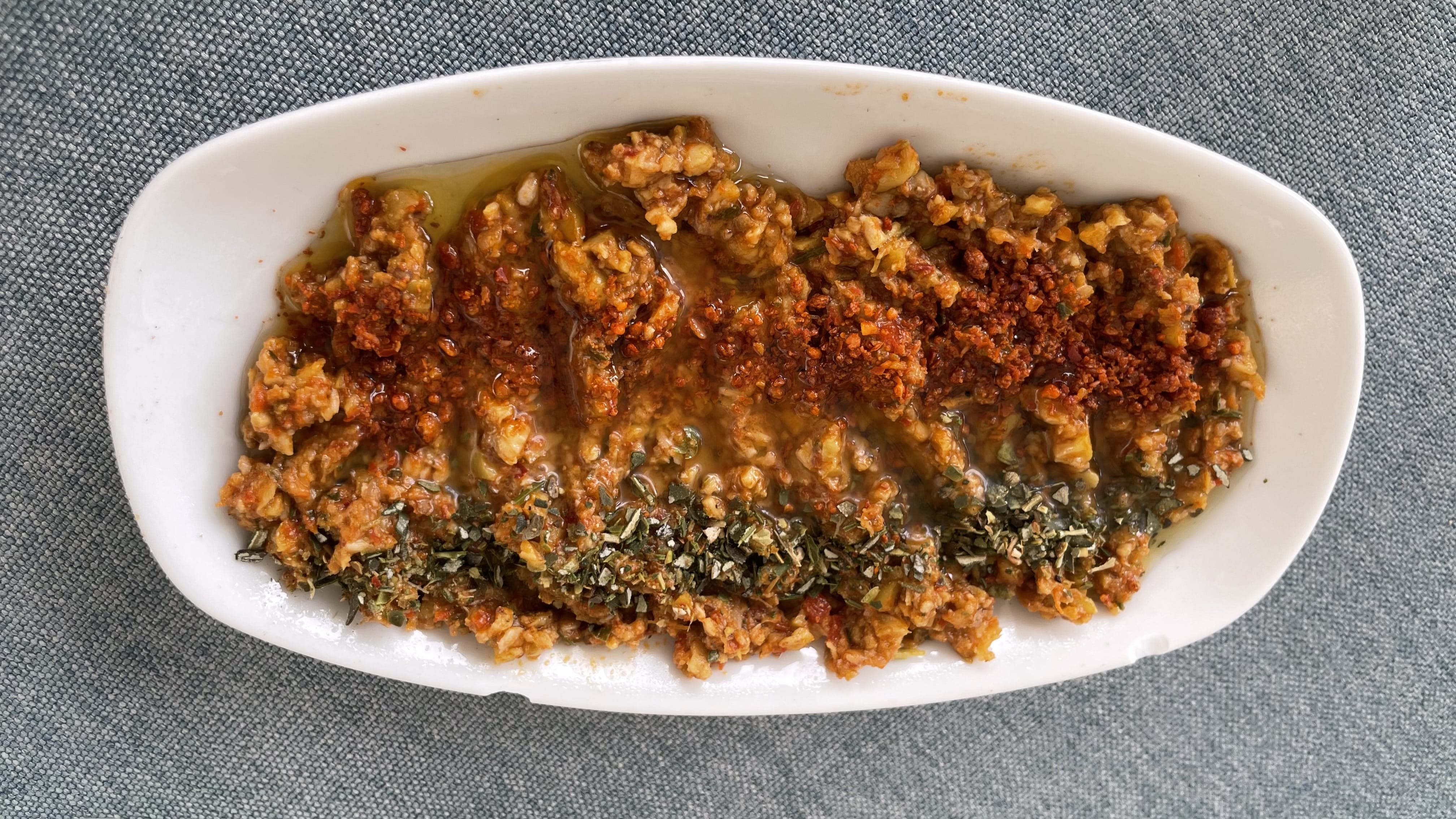
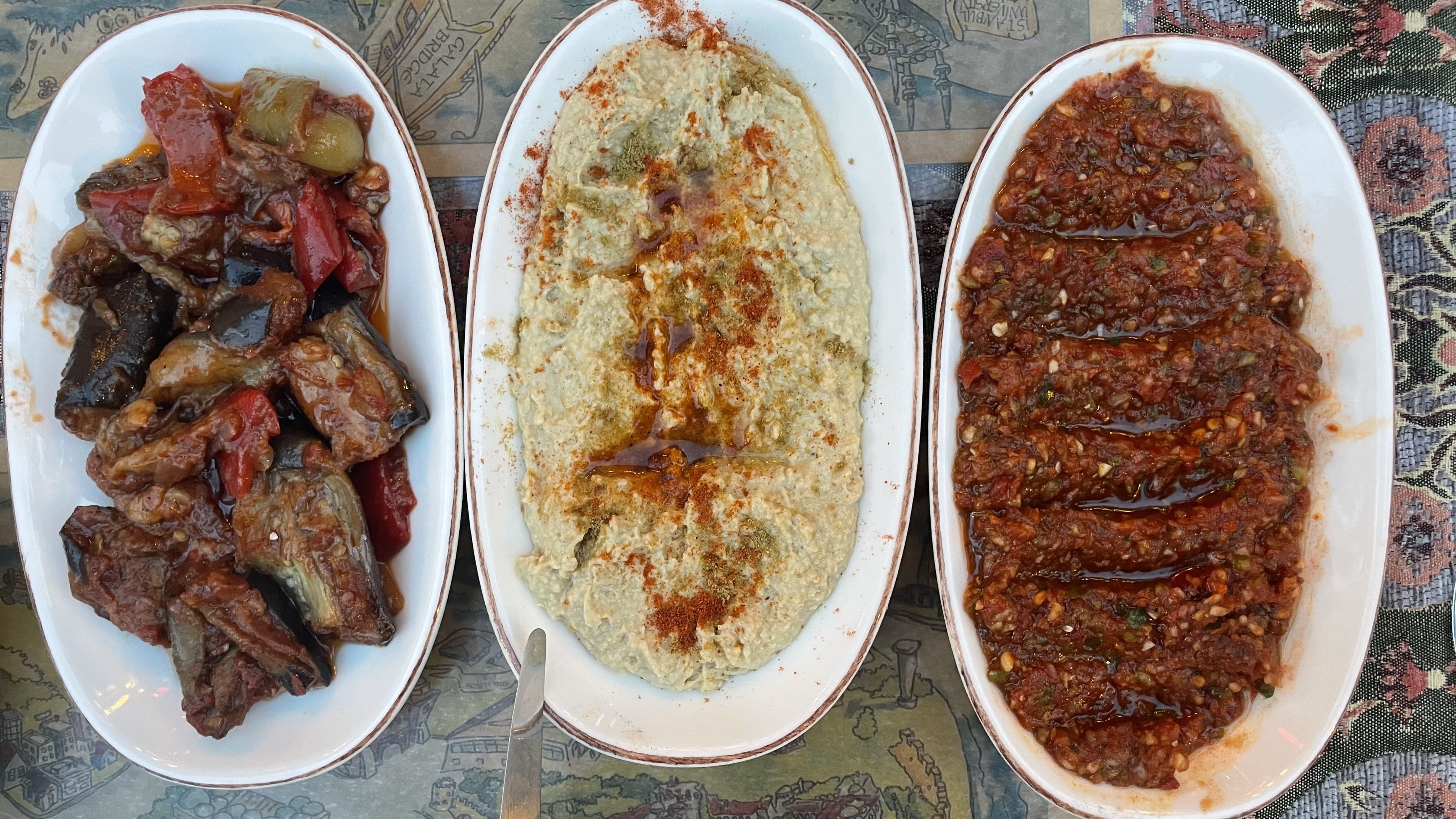
Every restaurant’s meze was a little different, all good, but one place in particular stood out: Kybele Café. Their hummus might have been the best I’ve ever had — thick, smooth, and with a nutty taste I hadn’t come across before. They also served the best lavaş(la-vash)—, the puffed bread that came to the table hot and golden. (Even at home I’m a freak for hummus, so I was happy to find it at every meal.) And with all that bread for dipping, I usually ate more than I planned.
I noticed how many dishes leaned on the same ingredients — eggplant, chickpeas, yogurt, olive oil, spices like cumin and paprika — just prepared in different ways. A lot of that goes back to the Ottoman Empire, when flavors from the Mediterranean and the Middle East came together. You can still taste it now: everyday ingredients, layered with flavor.
For something different, I tried pide (pee-deh), sometimes called Turkish pizza. It’s an oval, boat-shaped flatbread baked in a hot oven and topped with cheese, vegetables, or an egg. I went with a cheese one — warm bread, melted cheese. What could be better?
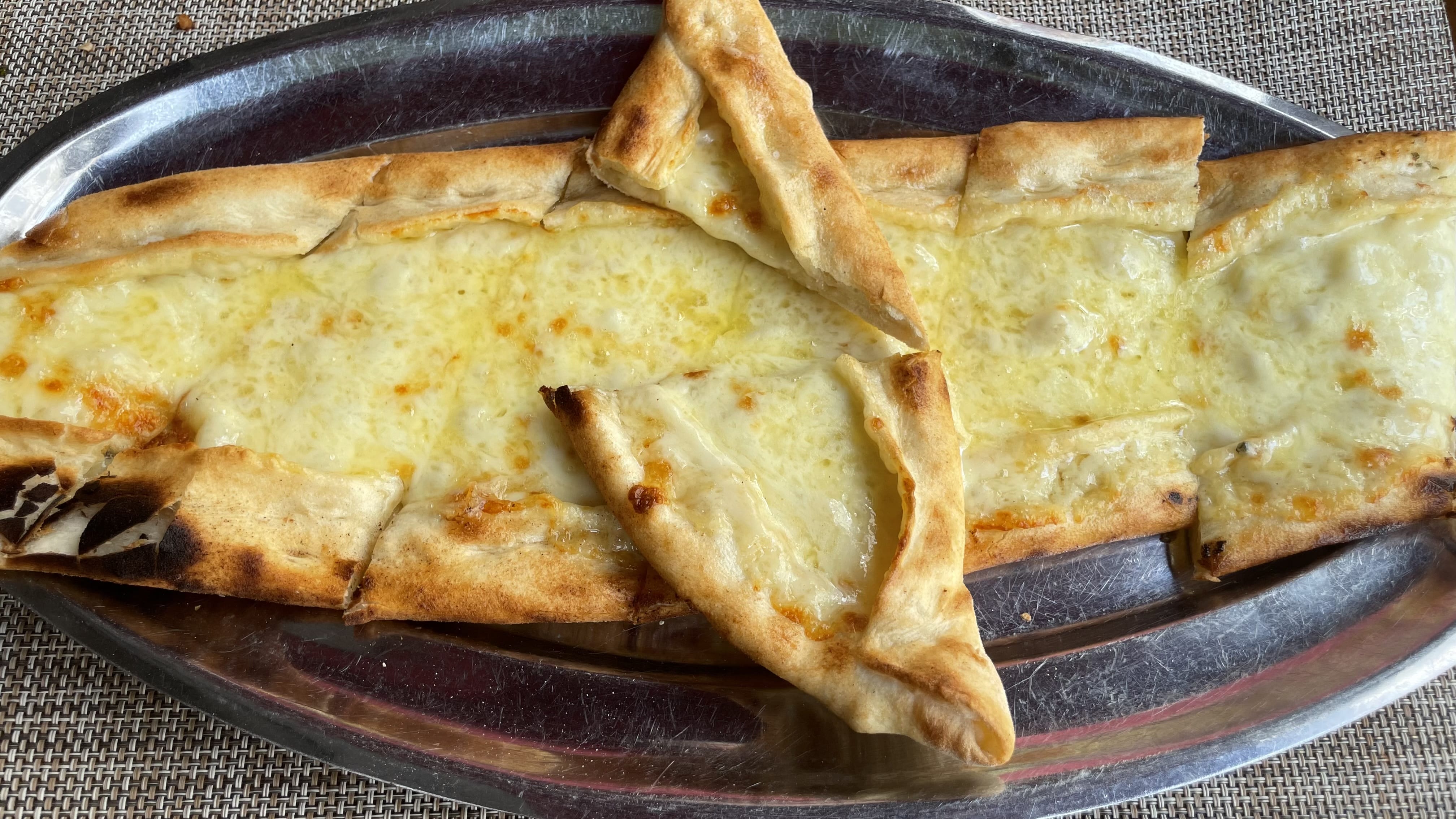
On my last day, I ordered çiğ köfte (chee kof-teh). Traditionally it’s made with raw meat, but the vegetarian version is common now, using bulgur, tomato paste, spices, and herbs. The one I had was shaped into little ridged pieces and served with lettuce and lemon. You scoop it into the lettuce, squeeze some lemon juice on top, and eat it almost like a wrap. Spicy, fresh, and surprisingly filling.
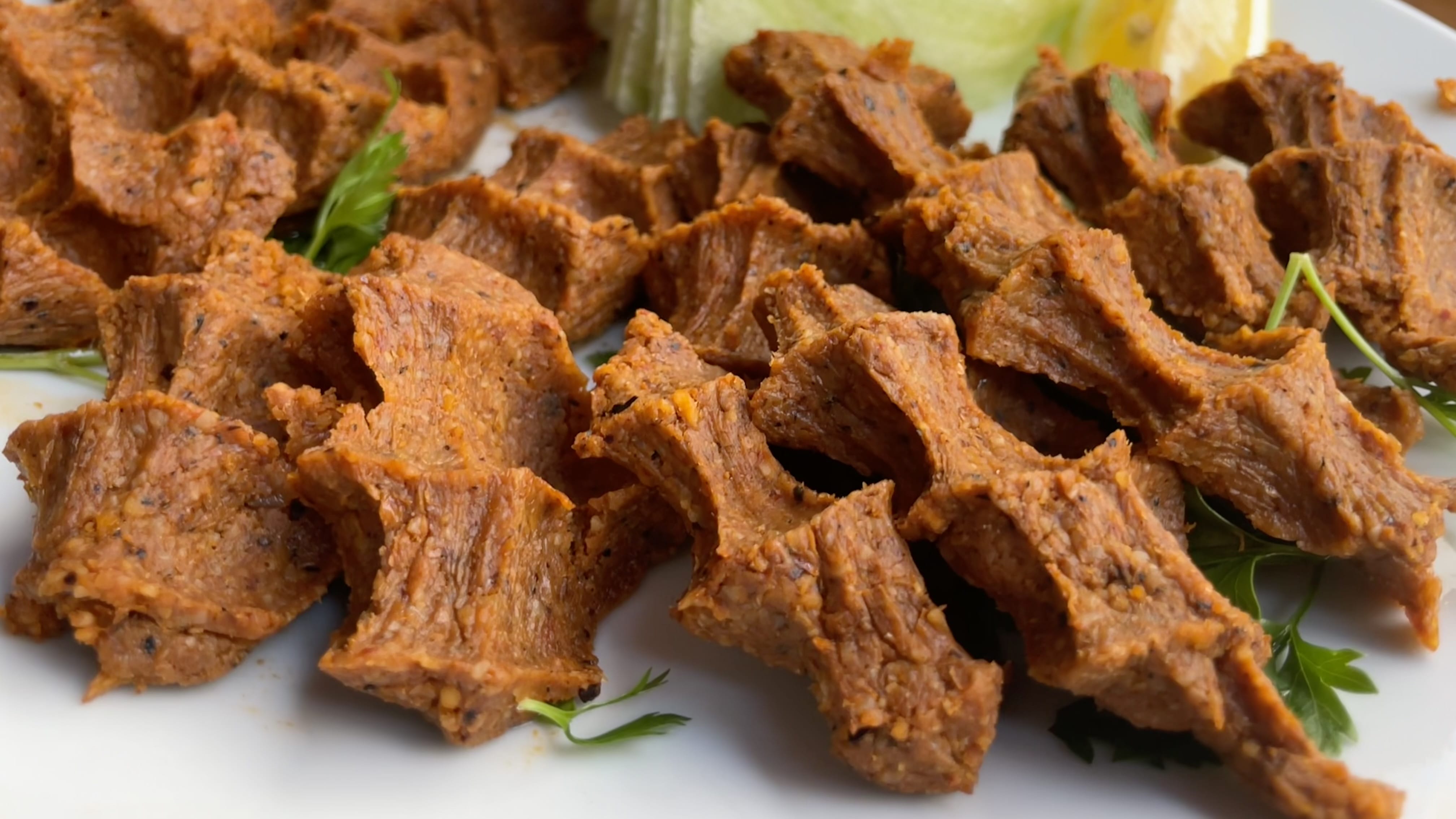
And when I wanted something lighter, I went with grilled vegetables. Eggplant, peppers, onions, and tomatoes was on nearly every menu, often with a side of bulgur pilaf.
If there’s one thing I can always enjoy anywhere I travel, it’s bread. Lucky me — because bread is such a staple in so many cultures, and Turkey is no different. In Istanbul, it showed up everywhere: on the street, in bakeries, and at nearly every meal.
I’d already mentioned simit, the sesame-crusted bread rings sold from little red carts or stacked high in bakery windows.
At restaurants, I was often served lavaş the puffed balloon bread that came hot from the oven, sprinkled with sesame and nigella seeds. It collapsed the second you tore into it, but it was warm, light, and impossible not to eat.
And then there were the bakeries — racks piled high with ekmek (ek-mek), the classic round white loaves, and long oval pide breads, both staples for locals. By the door, you’d usually see rows of simit waiting to be taken home. I always think bread looks like a work of art, and here it really did — fresh, golden, and impossible to ignore.
Bread isn’t just something extra in Turkey — it’s part of daily life. Whether it was simit grabbed from a street cart, lavaş served before dinner, or loaves of ekmek carried home under people’s arms, bread was everywhere in Istanbul.
Baklava is probably the most famous Turkish sweet, and for good reason. It’s made from layers of paper-thin pastry brushed with butter, filled with chopped nuts, and soaked in syrup or honey. And just like cookies at home, there isn’t just one kind — there are endless variations. Some are cut into diamonds, others rolled into logs or shaped into little rounds. The fillings change too: walnuts, hazelnuts, almonds, pistachios.
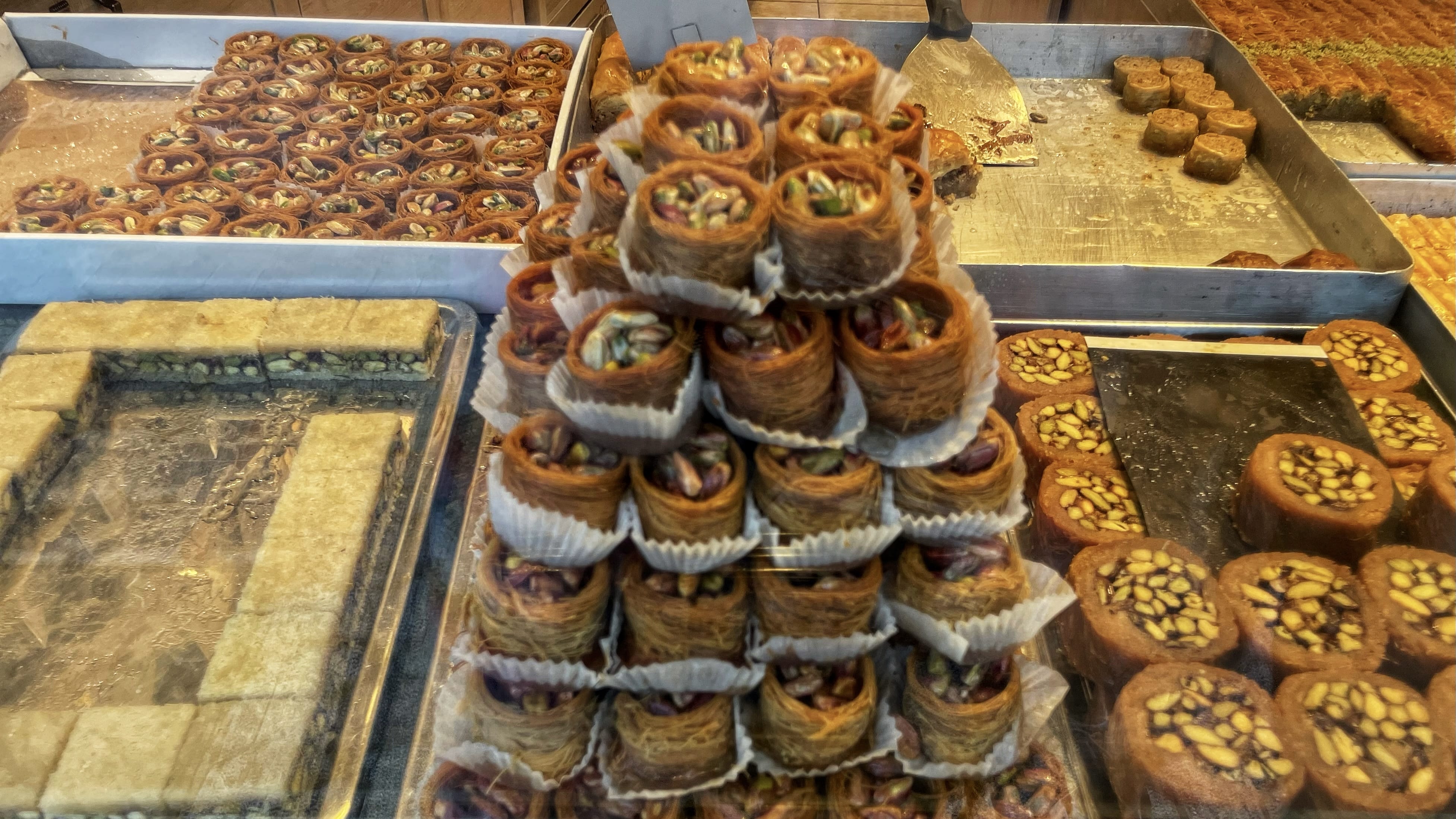
Sampling the differences became part of the fun. One of my favorites was a pistachio baklava with bright green filling and flaky golden pastry, the top generously covered in crushed pistachios. It was rich without being heavy, and for some reason it paired perfectly with a strong cup of Turkish coffee.
Beyond baklava, wandering the bazaars opened up a whole other world of sweets. I loved churchkhela — strings of walnuts dipped in thickened grape or fruit juice until a glossy, chewy coating formed around them. The best way I can describe them is like walnuts wrapped in a natural fruit roll-up, and I kind of loved them. There were also sticky figs stuffed with walnuts and jewel-like nut-and-fruit confections stacked high in colorful displays. Turkish delight was everywhere too — chewy, sugar-dusted cubes flavored with rose, lemon, or pomegranate. Fun in small doses, but for me one or two bites were plenty.
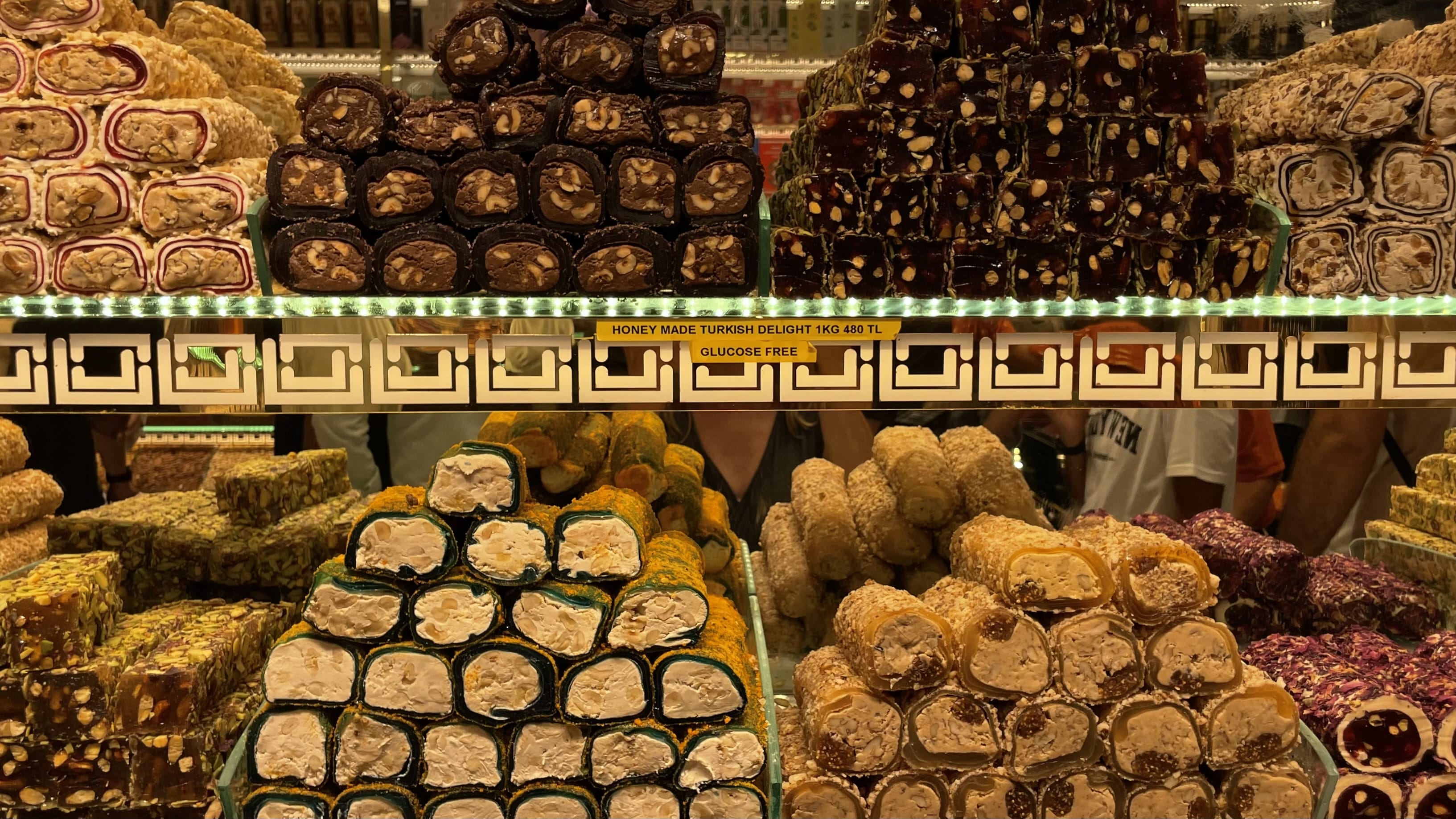
And of course, Turkish ice cream (dondurma) is famous for its unusual texture. Made with salep (a flour from orchid root) and mastic resin, it’s chewy, elastic, and slower to melt than regular ice cream. Vendors often turned it into a bit of a show, scooping and twirling it with long-handled paddles before finally handing it over. Watching the little performance was almost as fun as eating the ice cream itself.
One sweet my guide insisted I try was Noah’s pudding (Aşhure). At first glance, it didn’t look like much — more like a pale porridge topped with nuts and dried fruit — but it turned out to be surprisingly good. It’s made from a mix of grains, beans, and dried fruits, simmered together until it becomes thick and creamy.
Traditionally, it’s tied to a legend that when Noah’s Ark came to rest, the survivors gathered whatever ingredients they had left and cooked them all together in one pot. Today it’s considered a dish of sharing and community, often made in large batches and given to neighbors and friends. For me, it was another reminder of how Turkish food connects to history and culture.
Even though I’m not huge dessert person, I found myself lingering in the sweet shops and stalls just to see the artistry — trays of baklava, towers of dried fruit, and piles of nuts transformed into sticky confections. Sampling a few bites here and there (and discovering aşure) felt like another way of tasting Istanbul’s culture.
Turkish coffee is just as iconic, and it’s been part of daily life here for centuries. Brewed slowly in a small pot called a cezve and poured unfiltered into tiny cups, grounds and all, it’s recognized by UNESCO as part of the world’s intangible cultural heritage. The taste is intense — thick, strong, almost earthy — and sometimes flavored with cardamom or a hint of spice. For me, it was both familiar (thanks to a friend back home who made it often) and brand-new, because here I was sipping it in the place where it’s deeply woven into tradition.
No matter what you’re eating in Istanbul, drinks play just as big a role in the experience. Tea (çay) is everywhere — poured into small tulip-shaped glasses and served strong, hot, and often slightly sweetened. It’s the drink of hospitality, whether you’re sitting in a café or browsing through the bazaars.
Local beer was easy enough to find too. Mostly Efes — crisp, light, and easy to drink on a hot day. I’d have one with a meal once in a while, and it seemed to work well with the spices.
Eating vegetarian in Istanbul was easier than I expected. Menus almost always had a few options, and many traditional dishes are already plant-based. I did repeat certain things (mezze and simit became staples), but I never felt limited. If anything, I came home craving another piece of börek — that delicate spinach-and-cheese pie I had every morning.
Between breakfasts, meze plates, and street food, I never went hungry — and I left with a few new favorites I’d happily eat again tomorrow. And of course, I’d finish it all off the way locals do — with a glass of tea or a cup of coffee — the perfect ending to every meal.
Cats of Istanbul: Furry Ambassadors of the City
Street cats are everywhere in Istanbul, and they’ve become part of the city’s daily rhythm.
5 Days in Istanbul: A Love Affair with Turkey’s Most Famous City
From mosques and markets to ferries and Balat’s colorful streets, here’s how I spent five unforgettable days.

About the Author
Hi, I’m JoAnne—writer, wanderer, and lover of places that surprise me. I’ve traveled to 60+ countries (and counting), usually with a camera in one hand and a notebook in the other. I’m drawn to mosaics, markets, and mountains, and I write to remember what moved me. When I’m not traveling, I’m working on my blog Travels Afoot, trying new creative projects, or planning my next adventure. 📍 More about me | ✈️ Explore destinations